Top 27 Small or Dwarf Palm Trees with Identification Guide (Pictures and Name)
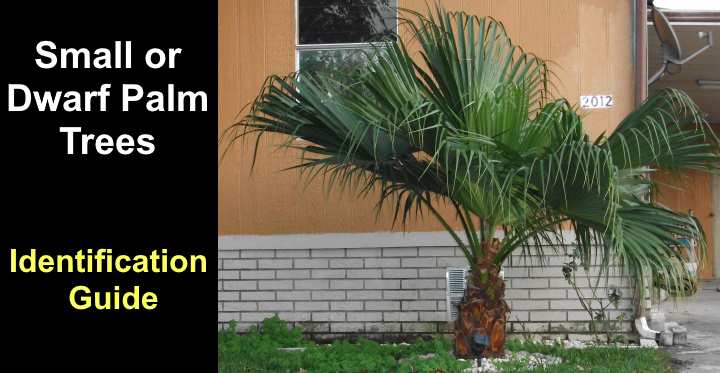
Small palm trees make a perfect addition to garden landscapes, especially in warm and sunny climates. Surprisingly, some varieties of small palms are also cold hardy, adding versatility to their appeal.
Dwarf palms are categorized as palm trees under 20 ft. (6 m) in height, typically featuring a single trunk, although some may have multiple trunks. Recognizable by their feather-like or fan-shaped fronds, all small or dwarf palm trees bring a touch of elegance and natural beauty to any outdoor space. Whether you’re seeking a tropical vibe or a compact focal point, these small palm trees offer a range of options for garden enthusiasts.
In this article, you’ll find some of the most popular species of small palms. You’ll find short palms that grow in warm climates such as Florida, and other dwarf palms that are cold hardy and can withstand freezing temperatures.
The Advantages of Small Palm Trees for Your Outdoor Space
One of the major benefits of planting dwarf palms in your front or backyard is their compact size, allowing them to fit perfectly without overshadowing your space or blocking sunlight. Some smaller palm varieties even thrive in containers, offering versatility in placement.
While small palms can reach heights of up to 20 feet (6 m), numerous miniature palm species remain at a manageable 5 feet (1.5 m) when fully grown. Additionally, contrary to popular belief, many small palm varieties are well-suited for temperate climates, expanding the options for palm enthusiasts
Small Palm Tree Facts
Small palm trees, such as the dwarf palmetto, typically grow to a height of about 4 to 6 feet (1.2 m – 1.8 m). On the other hand, taller varieties like the spindle palm can reach heights of up to 20 feet (6 m). Although a 20-foot palm tree may seem tall, it is still considered small compared to larger palm tree species that can grow as tall as 100 feet (30 m).
Compact palm trees are primarily cultivated in gardens for their visually pleasing appearance in the landscape. Their smaller size makes them ideal for planting in front yards or transforming a garden into a tropical oasis.
Most small palm tree varieties have a small root ball, allowing for close proximity to buildings. Thriving in warm climates, many small palm trees also bloom and bear deliciously sweet fruit.
How to Identify Small Palm Trees
Identifying species of small palm trees involves observing the shape of their leaves (fronds) and the characteristics of their trunks. Palm trees can be categorized into two main types based on their leaf structure: feather-like leaves (pinnate) or fan-like fronds (palmate). Additionally, various dwarf palms have distinct trunk features, including slender and smooth trunks or trunks with husks that create a spiky appearance.
The appearance of different palm species varies significantly. Some palms have slender trunks with a lush crown of gracefully arching fronds. Other palm types feature thick, hairy trunks that have a rough texture. Certain miniature palm species have a clumping, bush-like growth pattern, with leaves seemingly emerging directly from the ground, without a visible trunk.
Types of Small Palm Trees (With Pictures)
Here are the best dwarf or small palm trees to grow in your garden landscape.
Dwarf Palmetto (Sabal minor)
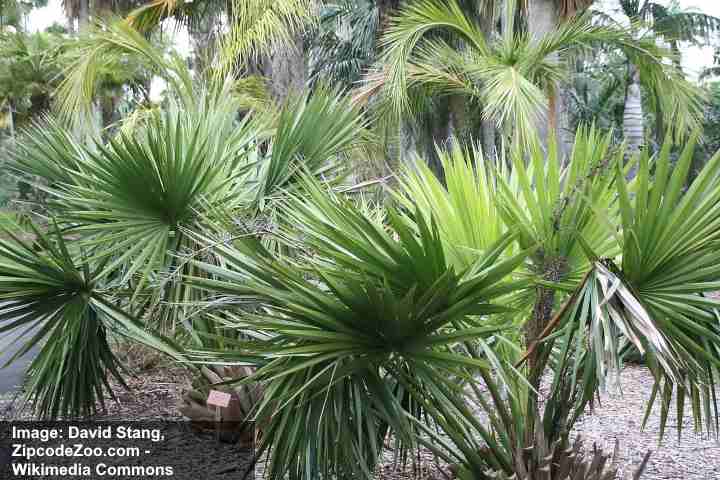
The Dwarf Palmetto is a cold-hardy miniature palm that thrives in a variety of habitats
The Dwarf Palmetto is a delightful miniature palm tree and one of the smallest palm tree species, reaching a height of 3 to 6 feet (0.9 to 1.8 meters). Its petite stature makes it an excellent choice for gardens with limited space.
The Dwarf Palmetto is a versatile palm plant that can thrive in partial shade or full sun, adapting well to different light conditions. It prefers well-draining soil with moderate moisture levels. With its compact size and easy-to-meet sun and soil requirements, it is an ideal choice for those seeking a charming and low-maintenance small palm tree that brings a taste of the tropics to their outdoor garden space.
The Dwarf Palmetto is classified as a Zone 7 to 10 plant according to the USDA hardiness zones, indicating its ability to withstand colder temperatures. It thrives in hot, humid conditions but is also cold tolerant to 0°F (-18°C).
Landscape applications of the Dwarf Palmetto palm tree are diverse. As native plants in Florida, they can be planted together in a backyard to create a lush and bushy privacy screen. Alternatively, you can cultivate them in containers on your patio, infusing a tropical ambiance to your outdoor space.
USDA Zone: 7-10
Sun Exposure: Full sun to partial shade
Plant Size: 3 to 6 feet (0.9 to 1.8 meters)
Dwarf Sugar Palm (Arenga engleri)
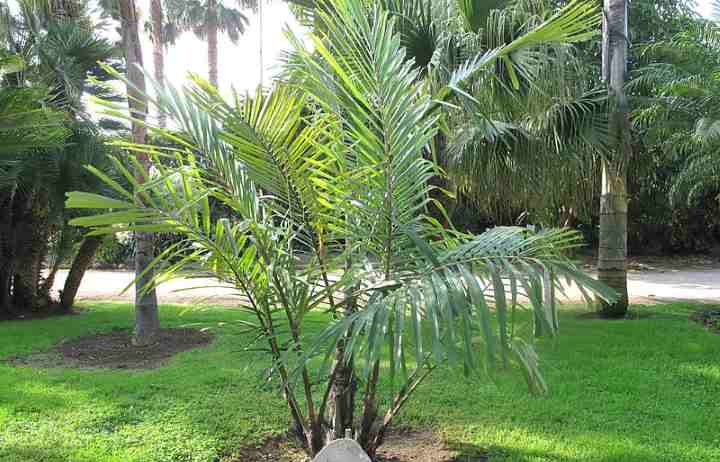
The dwarf sugar palm adds a decorative touch to a small front yard or backyard
The Dwarf Sugar Palm is a compact, multi-stemmed palm tree that reaches a height of 6 – 8 ft. (1.8 m – 2.4 m). Its clumping growth nature gives it a bushy appearance, resembling a large shrub. This small palm tree is characterized by vibrant green pinnate leaves that seem to emerge directly from the ground.
For optimal growth, the Dwarf Sugar Palm thrives in full sun, requiring a minimum of 6 hours of direct sunlight daily. It also prefers well-drained soil with good moisture retention, ideally with a slightly acidic to neutral pH level.
With its suitability for USDA zones 9 to 11, the Dwarf Sugar Palm is an excellent choice for gardeners residing in mild to warm climates. While it can tolerate temperatures as low as 25°F (-4°C), it is best to provide shelter from frost.
Landscape uses of this palm tree: The Dwarf Sugar Palm is an ideal option for those looking to create a stunning focal point without overwhelming their garden. Its petite stature allows it to thrive in various garden settings, including courtyards, patios, or even as a potted plant.
USDA Zone: 9-11
Sun Exposure: Full sun
Plant Size: 6 – 8 ft. (1.8 m – 2.4 m)
Pygmy Date Palm (Phoenix roebelenii)
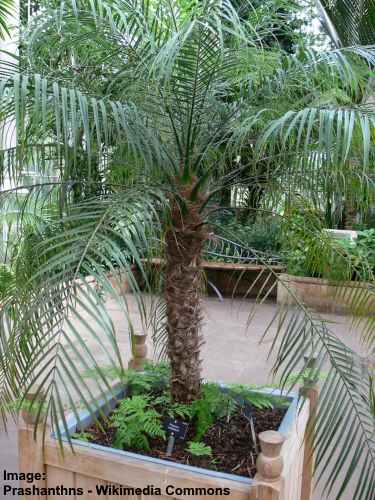
The pygmy date palm is a type of little palm tree with spiky trunk
The Pygmy Date Palm, also known as the Miniature Date Palm, is the perfect choice for gardeners seeking a small palm tree to enhance their outdoor garden space. With a compact size and an average height of 6 to 10 feet (1.8 to 3 meters), this palm tree is ideal for limited garden areas. Its unique feathery, arching fronds add an elegant and tropical allure to any landscape.
The Pygmy Date Palm is identified by a crowning mass of gracefully arching pinnate fronds. While typically a single-stemmed palm, it can occasionally develop multiple trunks, adding to its visual interest.
One of the distinguishing features of this small palm tree is its ability to produce small, edible dates when both male and female plants are present.
Thriving in full sun exposure, the Pygmy Date Palm requires a minimum of 6 hours of direct sunlight daily. It also adapts well to partially shaded areas, making it versatile for various garden settings. This palm tree prefers well-drained soil with good moisture retention and can tolerate a range of soil types, including sandy or loamy soil.
The Pygmy Date Palm is suitable for USDA hardiness zones 9 to 11, making it well-suited for gardeners residing in mild to warm climates. It can withstand temperatures as low as 20°F (-7°C) when mature, but young plants may require protection from frost.
Landscape uses of this palm tree: Grow pygmy date palms to accent a Mediterranean garden landscape. The mini palm tree is also a suitable container plant to keep indoors during winter.
USDA Zone: 9-11
Sun Exposure: Full sun
Plant Size: 6 to 10 feet (1.8 to 3 meters)
Bottle Palm (Hyophorbe lagenicaulis)

The small ornamental Bottle palm tree has a thick short trunk
The Bottle Palm is an exquisite small palm tree with an average height ranging from 10 to 12 feet (3 to 3.6 meters). It is known for its distinctive bottle-shaped swollen trunk, which gives it its unique name. This mini palm tree has elegant, arching, feather-like fronds that can grow up to 12 ft. (3.5 m) long, further enhancing its visual appeal.
As the Bottle Palm matures, its trunk elongates and develops a husky exterior, adding to its charm. These short bottle palm trees thrive in warm climates like Florida and southern California, where they can enjoy year-round warm temperatures. Full sun exposure is essential for the optimal growth of these small palms.
To ensure healthy growth, it is recommended to plant the Bottle Palm in a location that receives a minimum of 6 hours of direct sunlight daily. This palm tree prefers well-drained soil with good moisture retention and can adapt well to various soil types, including sandy or loamy soil.
The Bottle Palm is suitable for USDA zones 10 to 11, making it an ideal choice for gardeners residing in mild to warm climates. It can tolerate temperatures as low as 30°F (-1°C) but should be protected from frost.
Landscape uses of this palm tree: The small bottle palm trees, characterized by their distinctive bottle-shaped trunks and graceful fronds, are perfect focal points in compact landscape designs. In colder climates, they can be grown in containers, allowing gardeners to bring them indoors and provide protection from frost.
USDA Zone: 10-11
Sun Exposure: Full sun
Plant Size: 10 to 12 feet (3 to 3.6 meters)
Pindo Palm (Butia capitata)
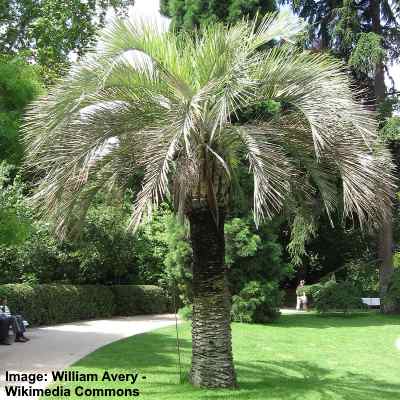
The small Pindo palm tree is a slow growing and cold-hardy and is excellent for compact outdoor residential area
The Pindo Palm (also known as the Jelly Palm) is a slow-growing, small tree that reaches heights of 15 – 20 ft. (4.5 – 6 m). The Pindo Palm is recognized by its elegant feather-like fronds and silver-gray foliage, giving it a tropical and attractive appearance. The fruits of the Pindo Palm are bright yellowish-orange and have a sweet, tart-like flavor, making them a great ingredient for jellies and jams or general consumption.
For optimal growth, the Pindo Palm thrives in 6-8 hours of direct sunlight, although it can tolerate partial shade. It requires well-draining soil to prevent root rot. The Pindo Palm is cold hardy, capable of tolerating temperatures down to around 14°F (-10°C).
The Pindo Palm is highly drought-tolerant, making it an excellent choice for regions with dry climates or limited water availability. Proper irrigation during the establishment phase is crucial for promoting its healthy development and growth.
The Pindo Palm’s compact size makes it suitable for small gardens, urban landscapes, or container gardening. With its slow growth rate and low maintenance requirements, it is a popular choice for homeowners looking for a visually appealing, easy-to-care-for palm tree.
USDA Zone: 8-11
Sun Exposure: Full sun to partial shade
Plant Size: 15 – 20 ft. (4.5 – 6 m)
Saw Palmetto (Sereona)
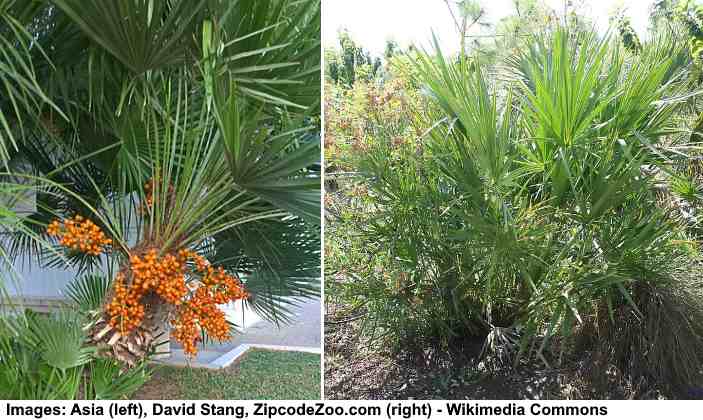
Saw palmetto is a multi stem low palm with bushy appearance that can also grow in a container
Native to Florida, the saw palmetto is a low-growing palm tree that reaches a height of 3 – 6 ft. (0.9 – 1.8 m). It is characterized by its distinctive, silvery-green fan-shaped fronds and dense, clumping growth habit. The edges of its leaves are serrated, which is why this small palm tree is named the saw palmetto. Being a type of clustering palm, this palm tree has multiple stems growing from the ground.
The fruits of the saw palmetto are small berries that are initially green but turn dark purple or black when fully ripe. These berries are not usually consumed, instead they are known for their medicinal properties and are often used in herbal supplements.
The saw palmetto requires full sun exposure of around 6 hours a day. This palm tree prefers well-drained soil and can tolerate both dry and moist conditions, making it adaptable to a variety of landscapes.
The saw palmetto can tolerate harsh environmental conditions such as drought, as well as temperatures down to around 10°F (-12°C).
The saw palmetto is a highly desirable palm tree among homeowners due to its low maintenance requirements and ability to add charm and beauty to outdoor spaces. Its ease of care makes it an ideal choice for those seeking a hassle-free addition to their gardens or landscapes.
USDA Zone: 8-11
Sun Exposure: Full sun
Plant Size: 3 – 6 ft. (0.9 – 1.8 m)
Windmill Palm (Trachycarpus fortunei)
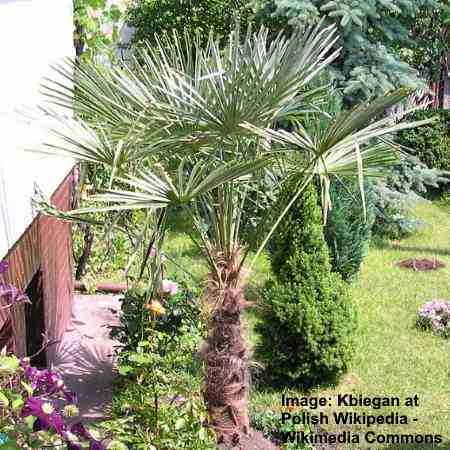
The windmill palm tree is very hardy and slow growing small palm
The windmill palm is a slow-growing, dwarf palm tree that typically reaches heights of 10 – 20 ft. (3 – 6 m). Its short, slender trunk has a gray-brown coloration and is covered with a dense layer of coarse, fibrous material, giving it a distinctive, hairy texture. At the top, the windmill palm has a crown of large, fan-shaped leaves that can span up to 3 ft. (1 m) in diameter. In springtime, it produces clusters of small yellow blossoms.
The windmill palm thrives in partial shade to full shade, although it can tolerate full sun as well. It prefers fertile, well-draining soil, though it can tolerate a range of soil types, including sandy, loamy, and clay soils, as long as they are not excessively alkaline or saline.
The windmill palm can tolerate minimum temperatures as low as 10 – 15°F (-12 to -9°C), making it suitable for regions with colder climates.
The windmill palm is a versatile palm tree that can be grown in pots, making it perfect for small gardens, patios, balconies, or rooftop gardens.
USDA Zone: 7-11
Sun Exposure: Prefers partial shade to full shade
Plant Size: 10 – 20 ft. (3 – 6 m)
King Sago Palm (Cycas revoluta)
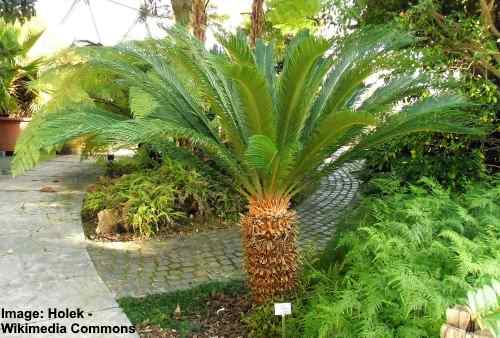
Sago palm is very slow-growing and can reach 20 ft. (6 m) after many decades
The king sago palm is not a true palm tree, but rather a slow-growing, small-sized cycad, reaching a height of 8 – 10 ft. (2.4 – 3 m). The king sago palm is easily identified by its crown of green, feather-like arching fronds, growing in a rosette pattern. The palm has a short, shaggy trunk. One of the most distinctive features of the king sago palm is the flower head, also known as a cone, that emerges from the center of the tree every three to four years. The cone consists of tightly packed scales and is usually a golden or brown color. The male cone features a taller and slender appearance, while the female cone is shorter and stockier.
The king sago palm is well-suited for warm, humid regions. It requires ample sunlight, ideally around 6 to 8 hours per day, to maintain its vibrant green color and healthy growth. The tree also prefers well-drained soil, and while it can tolerate some drought conditions, it thrives best with regular moisture to keep its roots hydrated.
The king sago palm thrives best in the temperature range of 65 – 75°F (18 – 24°C), though it can tolerate colder temperatures of up to 14°F (10°C).
Maintenance for the king sago palm is relatively low, making it a popular choice among gardeners. Regular watering, especially during dry spells, is essential to keep the tree healthy. When the fronds are of a brownish shade, it is recommended to trim them to help maintain its attractive appearance.
The king sago palm serves as an excellent accent or focal point in gardens, patios, and even indoor spaces. Its compact size makes it suitable for containers and small garden spaces.
USDA Zone: 9-11
Sun Exposure: Ample sunlight
Plant Size: 8 – 10 ft. (2.4 – 3 m)
Needle Palm (Rhapidophyllum hystrix)
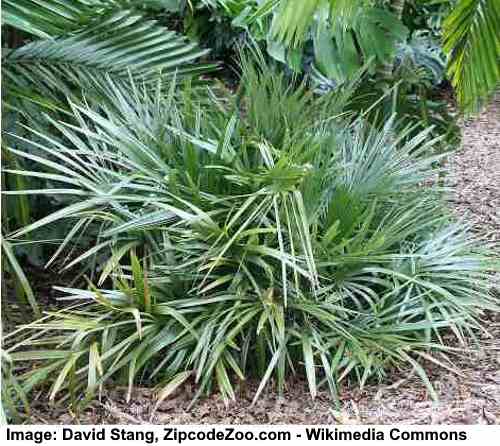
Needle palm is cold hardy and can grow as a miniature patio palm
The needle palm tree is a small, multi-stemmed, shrub-like palm with sharp, black needles on its spine. It can reach a height of 3 – 6 ft. (1 – 1.8 m), with a spread of up to 8 ft. (2.4 m). The compact palm has dense and bushy foliage. It is characterized by its glossy, fan shaped leaves which can grow up to 15 to 20 inches long (38 to 51 centims). The leaves have a vibrant green color on the top side and a silvery color on the underside. The tree has a stout trunk covered in rough, fibrous bark. It produces dense clusters of small, yellow to brownish flowers during the summertime.
The needle palm tree is cold hardy, capable of withstanding temperatures down to around 5°F (-15°C). It is drought-tolerant, and can be grown in either shade or full sun. It prefers well-drained soil, but can adapt to many soil types.
The needle palm is an excellent focal point in any outdoor garden, thanks to its distinctive leaves and rugged appearance. It is particularly suitable for enhancing a tropical atmosphere, especially in colder climates. With its bushy foliage, the needle palm can be effectively utilized to create privacy screens or hedges. The bushy palms also grow well in containers as an ornamental low-growing tree or specimen plant.
USDA Zone: 7-11
Sun Exposure: Can tolerate sun or shade
Plant Size: 3 to 6 ft. (1 – 1.8 m)
Parlor Palm (Chamaedorea elegans)
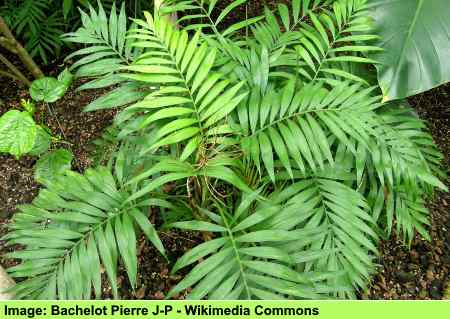
The parlor palm can be grown indoors as a houseplant or outdoors in small spaces
The parlor palm is a small palm tree that typically reaches a height of 4 to 6 ft. (1.2 to 1.8 m). The tree is known for its pinnate foliage with long broad leaves on the stems. Parlor palm trees grow from a single thin, slender trunk that divides into many thick branches. The flowers bloom in late winter to early spring. The female flowers are round and petal-less, while the male flowers are smaller, yellow, and green. If the flowers are pollinated, black fruits with seeds form, enabling propagation.
The parlor palm grows best in bright, indirect light and can tolerate partial shade. Direct sunlight can cause the leaves to burn and turn into a yellowish color. It thrives in well-drained soil. Maintenance is relatively low, though the plant will need to be watered once a week. If the palm has brown tips on the end of its leaves, it may indicate that the air is too dry, the environment is too cold, or that you have either under-watered or over-watered the plant.
The Parlor Palm is a resilient plant that can withstand temperatures as low as 50°F (10°C). However, it is highly susceptible to frost and can perish if exposed to freezing conditions.
Parlor palms are one of the most popular types of indoor palms. However, these palm plants can also be used in various outdoor landscapes, particularly in semi-shaded garden areas.
USDA Zone: 10-10b
Sun Exposure: Prefers bright, indirect sun
Plant Size: 4 – 6 ft. (1.2 – 1.8 m)
Spindle Palm (Hyophorbe verschaffeltii)
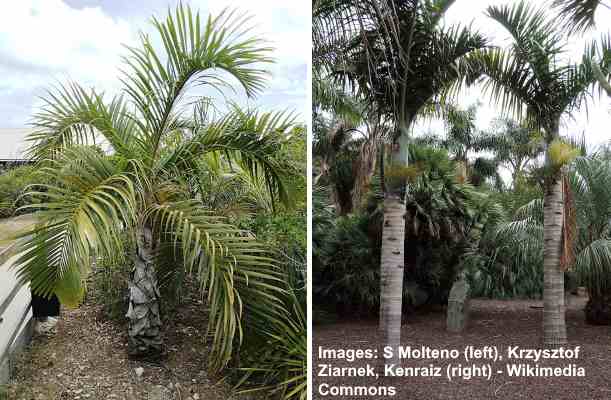
Young Spindle palm (left) and mature tree (right)
The spindle palm is a small palm tree that can reach a height of approximately 10 to 20 ft. (3 – 6 m). This mini palm is known for its slender, spindle-shaped gray trunk. The palm has a crown of curved, green pinnate leaves, which bulge from its center. The spindle palm produces small flower clusters that typically appear in clusters at the base of the crown.
The spindle palm thrives in full sun but can also tolerate light shade. It has a preference for well-drained, fertilized soil. The palm tree is drought-tolerant and salt-tolerant, making it suitable for coastal regions and landscapes. The ideal temperature range is around 60 – 85°F (15 – 29°C).
The spindle palm has a tropical look that makes it a great choice for creating lush and exotic landscapes. It is often used as focal points in tropical gardens or in coastal landscaping projects. The palm is most often used outside, though they are fairly common as indoor plants. Also, spindle palms grow well in containers if you live in temperate climates.
USDA Zone: 9b-10
Sun Exposure: Full sun, can tolerate light shade
Plant Size: 10 – 20 ft. (3 – 6 m)
Coontie Palm (Zamia floridana)
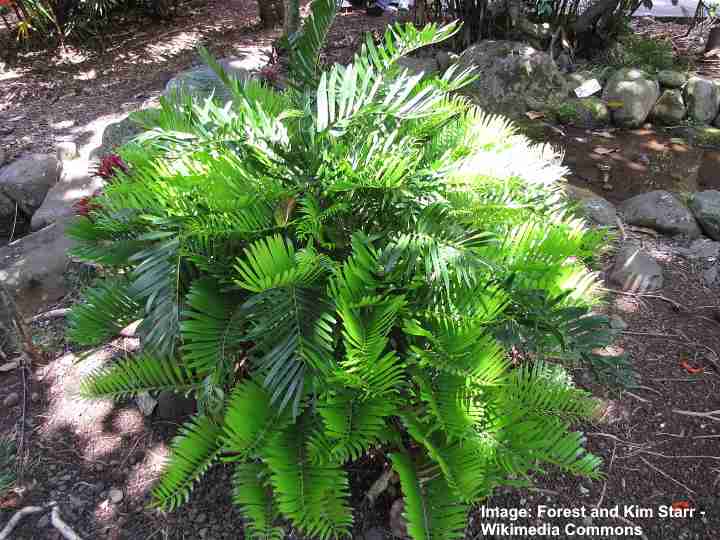
The low growing coontie palm looks like a type of bushy palm with rounded appearance
The coontie palm is a low-growing palm tree, native to Florida. It is characterized by its glossy, light-green, fern-like leaves. It is not a true palm, but rather a woody cycad. Coontie palms are more like bushes rather than actual palm trees. Over time, the palm grows a multi-branch cluster of fronds from the ground. The palm can reach a height of up to 3 ft. (1 m). The palm does not produce flowers or fruits, instead it produces reddish-brown cones with bright orange seeds, which can be used for propagation.
The coontie palm prefers full sun to partial shade. Although they can handle lower temperatures, it is recommended to grow the palm between temperatures of 75 – 90℉ (25 – 32℃). It prefers well-drained soil.
Coontie palms can be planted in large pots to create a tropical and visually appealing feature for patios, entryways, or pool areas. Their unique appearance with feathery foliage can add an exotic touch to your garden.
USDA Zone: 8-11
Sun Exposure: Full sun to partial shade
Plant Size: 3 ft. (1 m)
Triangle Palm Tree (Dypsis decaryi)
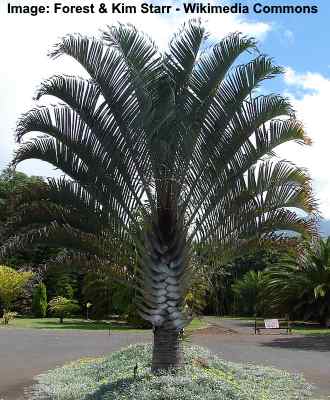
The small triangle palm has pinnate fronds that fan out from a single trunk
The triangle palm tree is a small to medium-sized palm distinguished by the unique triangular shape of its leaflets. It can reach heights of up to 25 – 30 ft. (7 – 9 m). The palm has a short trunk and long, gray-green to blue-green palmate leaves. This spectacular tree can have leaves up to 8 ft. (2.4 m) long that fan out from the thick central trunk.
As a flowering palm, the triangle palm can produce spectacular yellow-green flowers throughout the year, given the right conditions. These stunning flowers emerge on flowering stems that can grow over 3 ft. (1 m) in length.
The triangle palm tree is of low-maintenance and survives heat and drought well. It grows best in well-drained soil and full sun, though it can tolerate poorer soil and partial shade. It grows considerably fast when compared to other palms. It thrives best in tropical climates with temperatures of 70 – 85℉ (21 – 29℃).
Plant this palm as a focal point in landscape designs, thanks to its unique shape and eye-catching appearance. It can also be planted in groups to create a dramatic effect.
USDA Zone: 10-11
Sun Exposure: Full sun to partial shade
Plant Size: 25 – 30 ft. (7 – 9 m)
Mediterranean Dwarf Palm or European Fan Palm (Chamaerops humilis)

The Mediterranean dwarf palm (European fan palm) has several trunks and is small enough to suit many gardens
The Mediterranean dwarf palm is a low-growing clumping palm with three or more trunks at its base. This bushy multi-trunk palm tree can grow to between 10 – 20 ft. (3 – 6 m) tall and reach a width of up to 10 – 15 ft. (3 – 4.5 m). Its trunks have a rough, barky texture, and are brownish in color. A compact crown of rounded fan leaflets of a green to blue-green color grace the tops of the small trunks. The trunks grow slowly and are often tightly packed to each other. In spring, the palm produces flowers of a golden-yellow color.
The Mediterranean dwarf palm is a popular landscape palm in countries that enjoy hot summers. However, the palm is also cold hardy, withstanding temperatures as cold as 10°F (-12°C). It grows best in full-sun to partial shade. The palm prefers loamy, well drained soil, though it can tolerate a range of different soil types. It is drought tolerant and can thrive in a range of different environments.
The Mediterranean dwarf palm offers great landscaping potential with its compact size and attractive features. Use it in your garden to create visual interest and add a touch of elegance. Planting the palm tree in containers outdoors can help to control its height if you want to add a Mediterranean touch to your patio or decking area.
USDA Zone: 8-11
Sun Exposure: Full sun to partial shade
Plant Size: 10 – 20 ft. (3 – 6 m)
Florida Thatch Palm (Thrinax radiata)
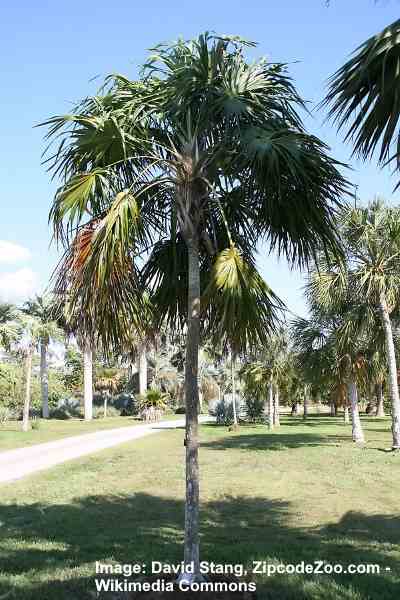
Florida Thatch Palm is commonly grown as a landscaping tree in residential areas
The Florida thatch palm is a small palm tree which can grow up to a height of 20 ft. (6 m). It features a single slender stem and a captivating canopy of deep-green palmate leaves. At the top of the tree, the underside of these leaves displays a striking silver hue. When growing in full sun, the fanning crown of palm leaves has a compact growth in a globular shape.
Florida thatch palms are popular residential landscape palms in Florida and other states in the southern U.S. This palm tree produces white flowers that bloom during late spring or early summer.
The Florida thatch palm thrives in full sun but can also tolerate partial shade. It prefers more coastal, warm climates, and is grown often in South Florida. The palm is drought-tolerant and salt-tolerant. It prefers sandy soil.
The Florida thatch palm is an ideal choice for small spaces, as it maintains a compact size. Plant this palm to give your landscape a tropical, beachy atmosphere. The palm is well-suited for narrow areas, as well as container planting.
USDA Zone: 10-11
Sun Exposure: Full sun to partial shade
Plant Size: 15 – 20 ft. (4.5 – 6 m)
Dwarf Majesty Palm (Ravenea hildebrandtii)
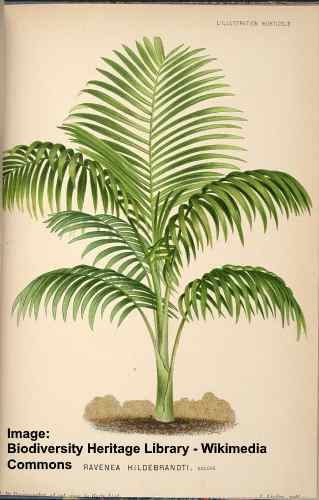
Dwarf majesty palm
The dwarf majesty palm is a single-trunk palm tree that doesn’t grow taller than 8 ft. (2.4 m). The dwarf palm has dark green pinnate leaves and a slender trunk that is only 3” (7 cm) thick.
The dwarf Majesty palm tree (Ravenea hildebrandtii) is a popular ornamental palm with large wide arching leaves. The large wide arching leaves look majestic as the focal point of any subtropical ornamental garden. The bright green leaves can grow up to 3 ft. (100 cm) long and have up to 100 leaflets growing along the stem.
Majesty palm is one of the best potted palm trees to grow outdoors.
Mazari Palm (Nannorrhops ritchiana)

Mazari palm is a small shrubby cold-hardy palm tree
The Mazari palm is a small, cold-hardy palm tree. It can reach a height of up to 10 – 20 ft. (3 to 6 m). The Mazari palm has palmate (fan-like) leaves of a blue-green to gray-green hue that grow on clusters of stems. The long, fan-shaped leaves can measure between 1 to 4 ft. (30 – 120 cm) long, which give it a shrubby, spiky appearance. The palm produces white flowers, which are arranged in tall clusters up to 10 feet (3 meters) long at the tip of the stems.
Like other types of cold-hardy palm trees, the Mazari palm needs hot summers to grow well. However, this species is also cold-hardy down to 10 °F (−12 °C). It is a sun-loving plant and grows best in full sun. The palm prefers well-drained, loamy soil, though it can adapt to other soil types. It is drought tolerant.
USDA Zone: 6-11
Sun Exposure: Full sun
Plant Size: 10 – 20 ft. (3 to 6 m)
Cat Palm (Chamaedorea cataractarum)
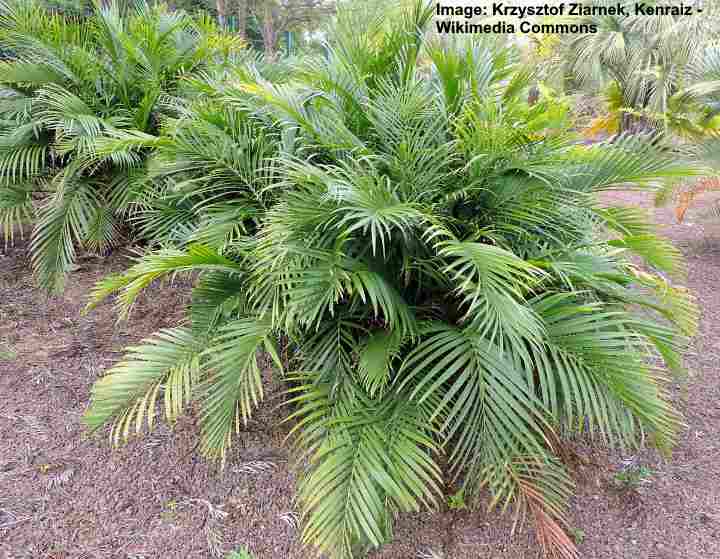
The multi-stemmed small cat palm is a great choice for small outdoor area
The cat palm tree is a clumping bushy palm plant with multiple stems growing from the ground. Growing up to 6.5 ft (2 m) in gardens, the short cat palm tree has glossy dark green leaves forming dense palm foliage. Cat palms require bright sunlight to thrive and a moist growing medium.
Due to the palm’s bushy growth habit and short stature, you can grow cat palms as a privacy hedge in tropical gardens. Cat palms also grow well in containers to add tropical greenery to a patio or decking area. These multi-stemmed palms are also popular indoor palm trees if you can grow them in bright light.
Discover many other types of palm trees to plant in your garden.
USDA Zone: 9-11
Sun Exposure: Full to partial shade
Plant Size: 6.5 ft (2 m)
Arikury Palm (Syagrus schizophylla)
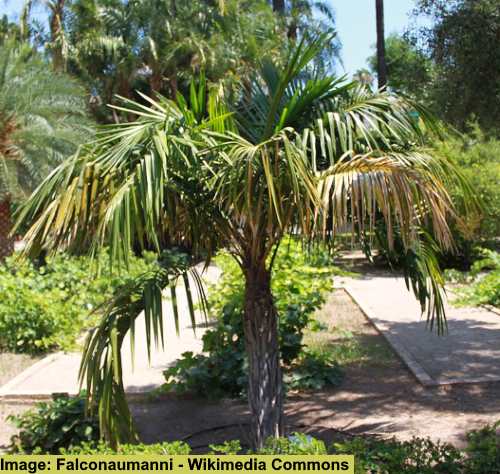
The Arikury palm is an attractive dwarf tree suitable for small sunny gardens or compact spaces
The arikury palm is a decorative dwarf palm tree with arching, bright green palmate leaves. Each palm frond has many long sword-shaped leaflets. This popular dwarf palm tree is characterized by its spreading crown, leaves with jagged edges, and bright orange-yellow flowers blooming on long, dangling stems growing 3 ft. (1 m) long.
The sun-loving arikury palm grows up to 6 ft. (1.8 m) tall, making it suitable for small gardens. Its arching fronds can measure 4 to 6 ft. (1.2 – 1.8 m), identified by a unique feature — thin purple-black stems with hooked spines near the base.
The dwarf arikury palm thrives in full sun in USDA zones 10 to 12.
Landscape uses of this palm tree: This heat-loving palm is compact and small, making it suitable for container planting to decorate patios or decks in tropical landscapes.
USDA Zone: 10-12
Sun Exposure: Full sun
Plant Size: 6 ft. (1.8 m)
Florida Cherry Palm (Pseudophoenix sargentii)
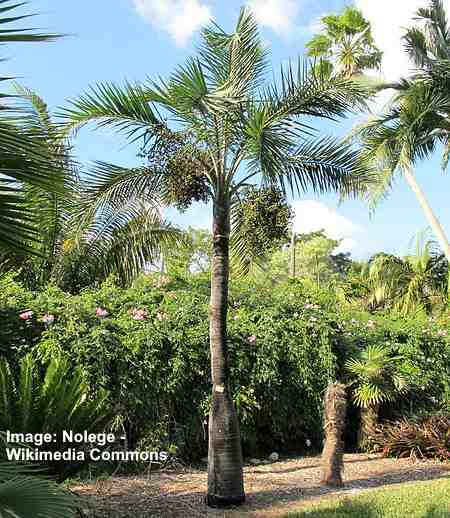
Florida cherry palm is a small to medium sized tree which is slow growing and cold sensitive
Also called the buccaneer palm, the native Florida palm tree is identified by its slender, smooth erect stem that bulges at the base. Other features of this exotic palm tree are its ringed trunk patterns, silver-green leaflets, and long branches that gracefully arch at the top of the stem.
The Florida cherry palm tree is a medium-sized palm. However, growing it in a container limits its size, making the small palm suitable for growing in a planter. Growing in the ground, this slender palm grows 10 to 25 ft. (3 – 7.6 m) tall and is characterized by a wide, spreading canopy.
Because it is slow-growing and relatively small — the height of some specimens maxes out at 10 – 12 ft. (3 – 3.6 m), it is suitable for compact tropical gardens.
Suitable for USDA zones 10 and 11, the slow-growing buccaneer palm has excellent salt and drought tolerance.
Landscape uses of this palm tree: The Florida cherry palm is ideal for growing in coastal areas because it tolerates salty air and high humidity. It also makes a great accent plant in any landscape where you want to add height and interest.
USDA Zone: 10-12
Sun Exposure: Full sun to partial shade
Plant Size: 10 to 25 ft. (3 – 7.6 m)
Broadleaf Lady Palm (Rhapis excelsa)

The Broadleaf Lady palm is a stunning multi-stemmed tree that can be cultivated in a pot within the comfort of your own home.
The broadleaf lady palm is a multi-stemmed palm tree with palmate leaves in fan shapes. Characteristics of this clustering bushy palm are its dark green, glossy narrow leaflets, slender, erect cane stems, and clusters of tiny yellow flowers. The attractive, easy-to-grow outdoor palm tree thrives in partial sun and shade, making it highly versatile in landscapes.
The hardy, drought-tolerant palm tree grows 6 to 15 ft. (1.8 – 4.5 m) tall and wide. Its common name comes from the finger-like narrow pointed leaflets growing on the stems. The palm resembles bamboo plants in many ways due to its reed-like stems.
The popular dwarf palm is suitable for USDA zones 9 through 11. In temperate climates, the lady palm is a popular indoor plant that grows well in pots and tolerates low light and humidity.
Landscape uses of this palm tree: Its clumping nature and dense foliage make the lady finger palm ideal in landscapes as a hedge or privacy screen. It also grows well as a container plant on patios.
USDA Zone: 9-11
Sun Exposure: Full sun to shade
Plant Size: 6 to 15 ft. (1.8 – 4.5 m)
Golden Cane Palm (Dypsis lutescens)
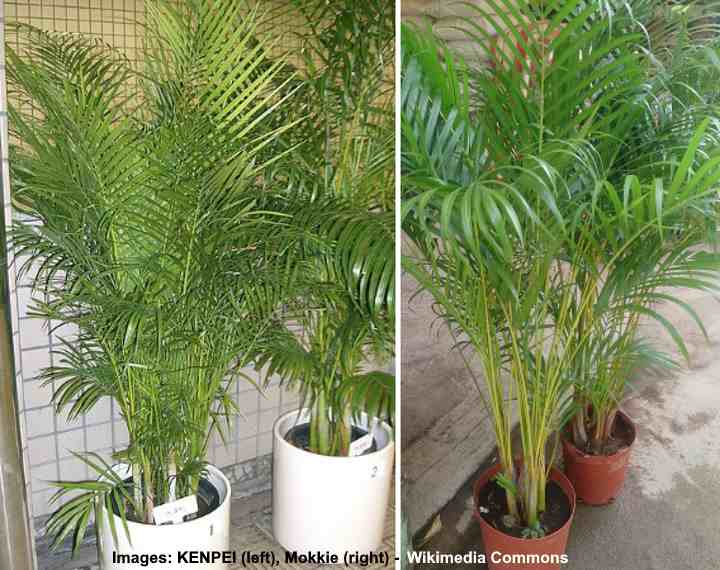
The golden cane palm (also known as areca palm) can be grown indoors and will give a tropical look to any space
The golden cane palm is a relatively low-growing bushy palm plant suitable for compact garden landscapes. The attractive shrub-like palm is characterized by dark green V-shaped fronds measuring 6 to 8 ft. (1.8 – 2.4 m) tall, lance-shaped leaflets, a multi-stemmed trunk, and small egg-shaped fruits.
Also called the areca palm or yellow bamboo palm, the bushy palm grows 20 to 35 ft. (6 – 10 m) tall, and its crown spreads 10 to 20 ft. (3 – 6 m) wide. In a landscape, the golden cane palm requires plenty of water, full sun to partial shade, and grows in well-drained soils.
Like the lady palm, the golden cane palm is a popular plant to grow in containers indoors.
Landscape uses of this palm tree: Growing in a garden landscape, the bushy golden cane palm is ideal as a natural fence, to grow along a wall, or to use as an accent plant.
USDA Zone: 10-11
Sun Exposure: Full sun to partial shade
Plant Size: 20 to 35 ft. (6 – 10 m)
Madagascar Palm (Pachypodium lamerei)
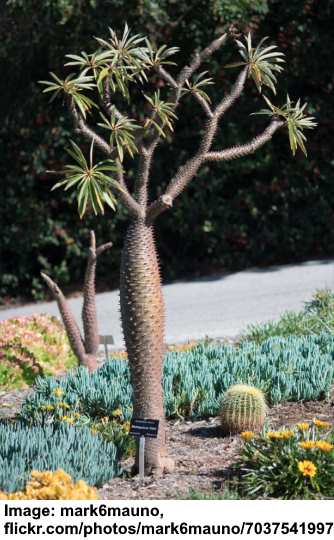
Madagascar palm is a small palm-like tree that can give a beautiful focal point to compact spaces
The Madagascar palm is a small deciduous tree unrelated to true palm trees. The palm-like tree is identified by its cigar-shaped spiny trunk, strap-shaped glossy green leaves, banana-shaped seed pods, and large saucer-shaped white flowers. As the plant matures, the base becomes swollen and fat.
The Madagascar palm tree is ideal for compact gardens due to its dwarf growth habit. The Madagascar palm grows 10 to 20 ft. (3 – 6 m) tall and up to 8 ft. (2.4 m) wide. Its large leaves grow 12” (30 cm) long, and its curled seed pods are 8” (20 cm) long. After the plant reaches 5 ft. (1.5 m) tall, it starts to branch at the top.
Landscape uses of this palm tree: The Madagascar palm looks spectacular as a specimen tree or growing in containers outdoors on a patio.
USDA Zone: 9-11
Sun Exposure: Full sun to partial shade
Plant Size: 10 to 20 ft. (3 – 6 m)
Loulu Palm Trees (Pritchardia spp.)
Loulu palm trees are native to Hawaii and vary in size from tall trees that can reach 50 ft. (15 m) tall to small or dwarf trees that reach up to 16 ft. (5 m) tall. They have a single trunk and are identified by large fan fronds on stalks measuring 2 to 10 ft. (0.6 – 3 m) long. Some species of Pritchardia have graceful arching branches with pleated round fronds. However, other varieties have drooping or weeping branches.
The fruits of Loulu palms are oval or spherical and grow in large clusters under the branches at the tree’s crown. The fruits can measure 0.75” to 2” (2 – 5 cm), depending on the species of the palm tree.
Some small species of Loulu palm trees include:
Pritchardia remota— A small palm tree endemic to the Hawaiian island Nihoa that typically reaches 13–16 ft. (4–5 m) tall. It has a slim ringed trunk, dense crown with fan-shaped leaves with drooping tips, and a small dark brown or black fruit.
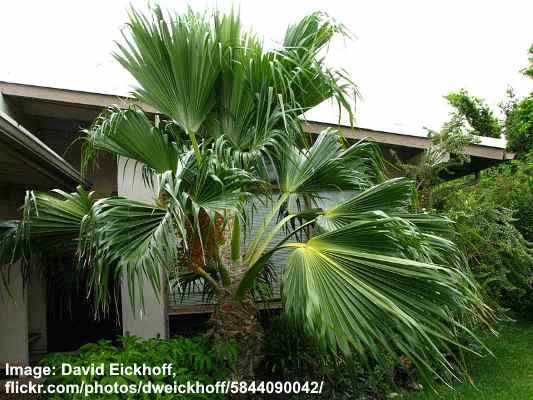
Pritchardia remota
Pritchardia munroi—A short Hawaiian palm growing 16 ft. (5 m) tall. It has drooping fan fronds that cover the entire tree, almost hiding the broad trunk from sight. It is native to dry and moist forests. Native to the Hawaiian islands Molokai and Maui.
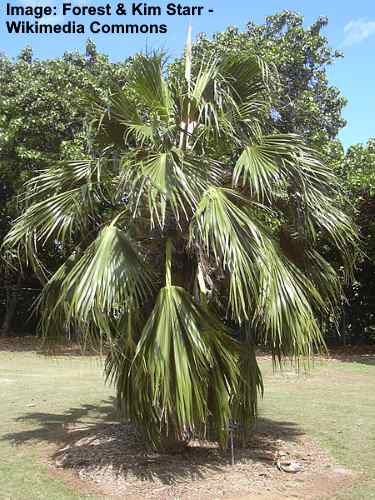
Pritchardia munroi
Pritchardia glabrata—This slow-growing dwarf Hawaiian palm grows 6.5 to 16 ft. (2 – 5 m) tall. It has an open crown with fan leaves, each measuring about 2 ft. (0.6 m) long. Native to Lanai and West Maui.
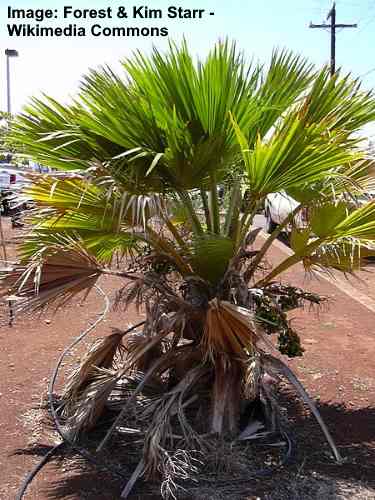
Pritchardia glabrata
Adonidia Palm (Adonidia merrillii)
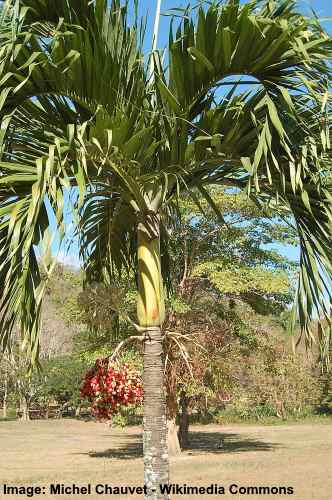
The small Adonidia palm tree is an excellent plant for landscaping when space is limited
The Adonidia palm, also known as the Christmas palm, is a palm tree characterized by its slender, smooth gray trunk. Although it can reach a height of up to 25 feet (7.62 meters), its growth rate slows significantly after reaching 6 ft. (1.8 m). Its graceful crown is adorned with long arching fronds that can spread up to 8 ft. (2.4 m) in width.
One of the benefits of cultivating this palm in your yard is its self-cleaning nature and low maintenance requirements. The Adonidia palm sheds its fronds more rapidly compared to other palm species, resulting in a consistently appealing appearance.
The Adonidia palm thrives in sunny locations, requiring full sun exposure to ensure optimal growth and development. It prefers well-draining soil with a slightly acidic to neutral pH level. Good soil drainage is crucial to prevent waterlogging, as excessive moisture can harm the roots of this small palm tree.
The common name ‘Christmas palm’ is derived from the palm fruit, which ripens in December, coinciding with the holiday season.
The small Adonidia palm thrives in USDA zone 10.
Landscape uses: Plant the Adonidia palm as a specimen tree to create a focal point in a sunny, tropical garden. In a front or backyard, you can plant the palm trees close together as they have a small root ball.
USDA Zone: 10-11
Sun Exposure: Full sun
Plant Size: 25 feet (7.62 meters)
Related articles:
- Small or Dwarf Evergreen Trees For Your Garden
- Small or Dwarf Weeping Trees for Landscaping
- The Best Indoor Palm Plants
- How to Grow Indoor Palm Trees as Houseplants
